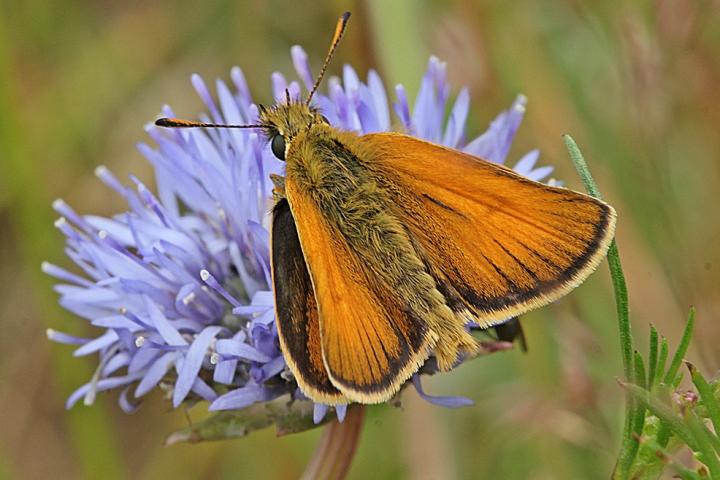DNA traces on wild flowers reveal insect visitors

The butterfly European skipper (Thymelicus lineola). Photo: Ole Martin Usage Restrictions: May be used in relation to this press release
Researchers from Aarhus University, Denmark, have discovered that insects leave tiny DNA traces on the flowers they visit. This newly developed eDNA method holds a vast potential for documenting unknown insect-plant interactions, keeping track of endangered pollinators, such as wild bees and butterflies, as well as in the management of unwanted pest species.
Environmental DNA (eDNA) can provide an overview of the DNA sequences in complex samples such as water and soil, and thereby a snapshot of the species inhabiting the particular ecosystem. In previous analyses of water samples from lakes and oceans, researchers have fx found DNA traces from insects, amphibians, fish and whales.
Flowers as DNA collectors
Flower-rich grassland habitats like meadows are typically visited by hundreds of species of insects such as bees, butterflies, flies and beetles, which collect food from the flowers. However, it can obviously be quite difficult to keep track of which insect species visit which flower.
But now, Associate professor Philip Francis Thomsen and Postdoc Eva Egelyng Sigsgaard from the Department of Bioscience, Aarhus University, have undertaken eDNA analyses of 50 flowers from seven different plant species.
“I have worked with DNA from water and soil samples for several years and have often thought that DNA is probably much more common in the environment than would initially imagine. With this study we wanted to test if eDNA from flowers can reveal which insects the flowers have interacted with”, says Philip Francis Thomsen, who heads a research group focusing on eDNA.
The researchers were quite surprised by the analyses, which revealed that the flowers have been visited by at least 135 different species of butterflies, moths, bees, flies, beetles, aphids, plant bugs, spiders, etc. The list goes on.
The flowers therefore function as passive DNA collectors that store data about each flower-visiting insect – a discovery that is published today in the prestigious international scientific journal Ecology and Evolution.
Efficient monitoring of our insect fauna
The method opens up completely new possibilities of studying the interactions between specific plants and insects. The knowledge gained can be used within many research areas, including applied research in pest control.
The new method also holds major perspectives in the management of endangered species like wild pollinators, which is an urgent task since many groups of flower-visiting insects are threatened. Thus, the populations of several wild bees and butterflies have decreased significantly in recent decades and many species have now become locally extinct.
“The eDNA method might provide a comprehensive overview of the insects involved in the pollination of various plants. Earlier the focus has almost entirely been on bees, butterflies and hoverflies, but we have found DNA from a wide range of other insects such as moths and beetles that may in fact also be important pollinators” says Philip Francis Thomsen.
###
Further information: Associate Professor Philip Francis Thomsen, Department of Bioscience, Section for Genetics, Ecology and Evolution, Aarhus University. Email: pfthomsen@bios.au.dk; Tel.: + 45 2714 2046
Read the scientific article: DOI: 10.1002/ece 3.4809
Media Contact
More Information:
https://www.eurekalert.org/pub_releases/2019-02/au-dto020719.phpAll latest news from the category: Life Sciences and Chemistry
Articles and reports from the Life Sciences and chemistry area deal with applied and basic research into modern biology, chemistry and human medicine.
Valuable information can be found on a range of life sciences fields including bacteriology, biochemistry, bionics, bioinformatics, biophysics, biotechnology, genetics, geobotany, human biology, marine biology, microbiology, molecular biology, cellular biology, zoology, bioinorganic chemistry, microchemistry and environmental chemistry.
Newest articles

NASA: Mystery of life’s handedness deepens
The mystery of why life uses molecules with specific orientations has deepened with a NASA-funded discovery that RNA — a key molecule thought to have potentially held the instructions for…

What are the effects of historic lithium mining on water quality?
Study reveals low levels of common contaminants but high levels of other elements in waters associated with an abandoned lithium mine. Lithium ore and mining waste from a historic lithium…

Quantum-inspired design boosts efficiency of heat-to-electricity conversion
Rice engineers take unconventional route to improving thermophotovoltaic systems. Researchers at Rice University have found a new way to improve a key element of thermophotovoltaic (TPV) systems, which convert heat…



